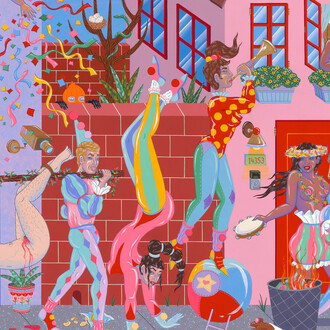Night Gallery is pleased to present Greensleeves, an exhibition of new paintings by David Korty. In the works throughout Greensleeves, the ceramic vessels that held bouquets in previous paintings have disappeared.
Instead, this new flora appears at eye level, jutting across light blue backgrounds, creating a tangled green matrix. Although confined to Korty’s sharply defined squares and rectangles, each image within seems to glow under the pressure of its hermetic environment. Amid the disc-like flowers and their accompanying, arrow-straight stems, other cut paper forms emerge that allude to Korty’s long-standing motifs—printed letters, circular voids that resemble hole punches or eyes—and include a new one, the artist’s handprint.
The exhibition title derives from a character’s name in the animated film Twice Upon a Time, directed by the artist’s father John Korty in the early ‘80s. As a teenager, David Korty lived on and off with his father in the three-story building in Mill Valley (Marin County, CA) that served as both a studio for the making of Twice Upon A Time and a makeshift home. Animators set up complex camera stands in the various bedrooms for the cut paper layouts and experimented with Korty’s brand of what he called “Lumage” (cut and dyed Pellon paper lit from behind on glass panes).
The studio became famous for its rogue techniques, one of which involved a 500-gallon aquarium that housed a photographic diorama of frozen city folk to be flooded with black ink for “The Nightmare Scene.” The movie’s unique, cut-paper imagery and imaginative use of zany humor eventually made it a cult classic. On the weekends, Korty wandered his father’s studio, borrowing the animators’ X-acto knives, templates, dyed paper, and hole punches. He also reportedly stole a few of their audio tapes, including David Bowie’s 1977 album Low.
Towards the end of his father’s recent illness, Korty shuttled back and forth from Los Angeles to his father’s northern California home, keeping his hands busy by traveling with a large cardboard box full of drawing materials and working on paper at night. It was during these late nights that Korty began to meditate on the profound impression his father’s work had made on his own.
Korty returned home to his Los Angeles studio and his signature cut-paper process. To make the works in Greensleeves, the artist first adheres Hahnemühle paper to his canvases, creating a smooth, taut surface. He then applies Flashe paint, colored pencil, and collage with monoprints and hand-cut- paper shapes. Korty builds his paintings layer by layer, often painting over or pasting out graphic passages which are later re-pasted with alternate images. Hard edges and bold geometries find their counterparts in the intimacy of his handprints and colored pencil marks.
Throughout Greensleeves, Korty preserves decades of impulses and recollections while continuing to push forward. Painting itself is an imperfect vessel, burdened by two-dimensional constraints and art history’s baggage. It’s also an ideal place to think about legacy and inheritance: adding and subtracting while waiting for the gift of sound and vision.
David Korty (b. 1971, San Francisco, CA) has shown extensively in Los Angeles, in solo exhibitions at Night Gallery, China Art Objects, Kohn Gallery and LAxArt; at Derek Eller Gallery and Greene Naftali in New York; and at Sadie Coles HQ in London. Korty's work has been acquired by the Har Museum, Los Angeles; the Grunwald Center for Graphic Arts, Los Angeles; the Judith Rothschild Foundation; and the Rubell Collection. His work has been covered in Artforum, The New York Times, The Guardian, and Modern Painters, among other publications. A monograph of Korty's work entitled Blue Shelves was published by Sadie Coles and Night Gallery in 2016. In 2020, he was awarded the Frederick Hammersley Visiting Artist residency at the University of New Mexico. He lives and works in Los Angeles.
















